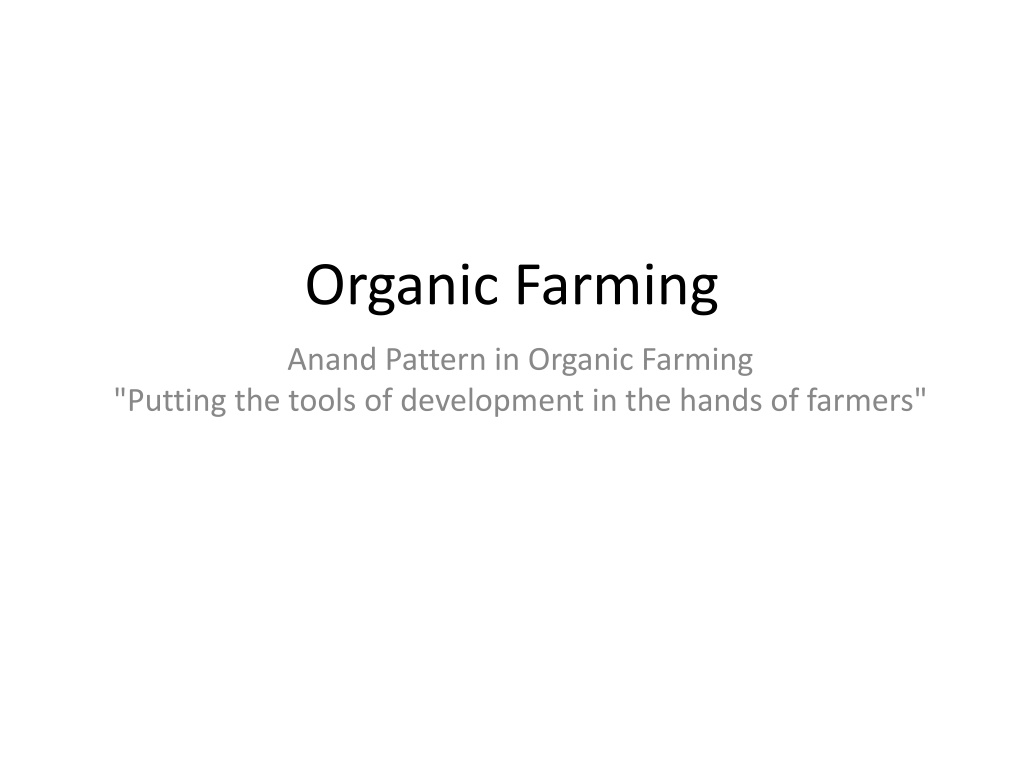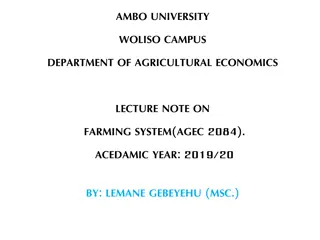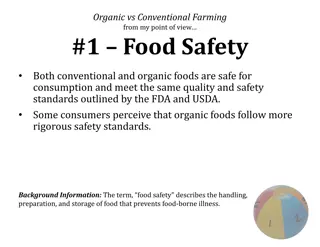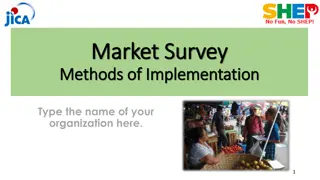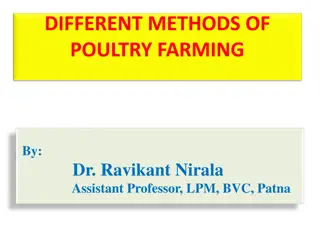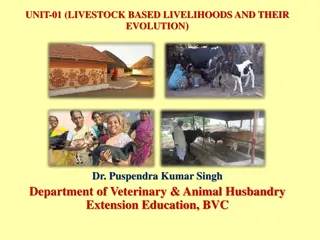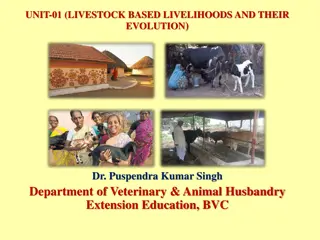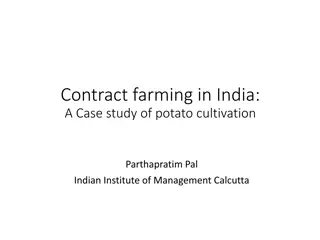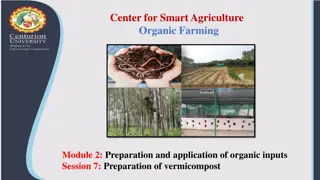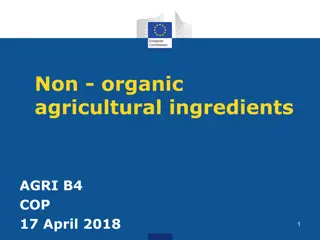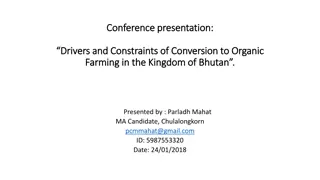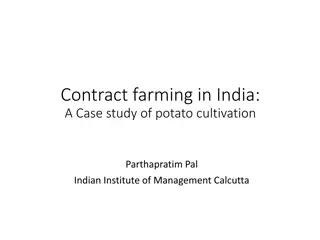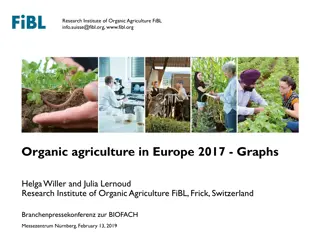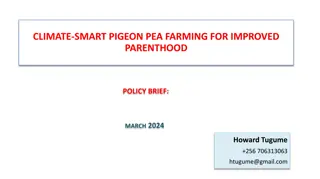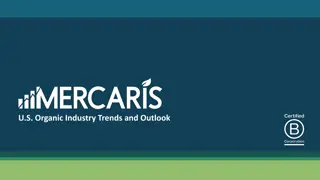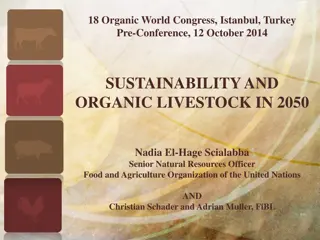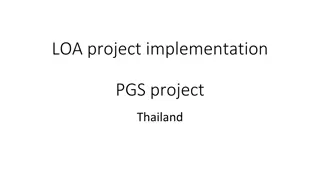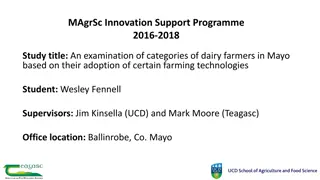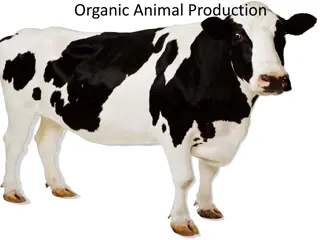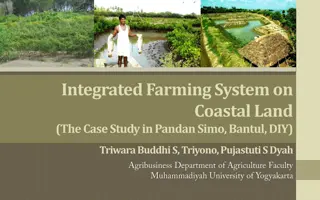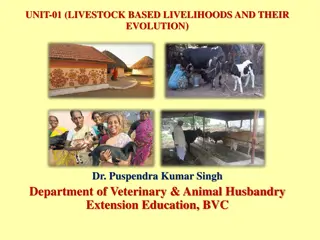Anand Pattern in Organic Farming: Putting Tools in Farmers' Hands
Organic farming with the Anand pattern focuses on sustainable practices, avoiding synthetic inputs, integrating technology with natural processes, and mobilizing soil nutrients. Learnings from small holdings in India and the North East reveal challenges and opportunities in accessing quality inputs, technologies, market facilities, and certification processes. The Organic Farming scheme aims to address climate, production, and market risks for environmentally sustainable and marketable volumes through farmer-controlled value-added production centers. Strategy implementation emphasizes contiguous clusters, women farmers, SHG focus areas, technology integration, soil assessment, and farmer support. Principal components include baseline surveys, farmer assessments, soil analyses, and cluster councils.
Download Presentation

Please find below an Image/Link to download the presentation.
The content on the website is provided AS IS for your information and personal use only. It may not be sold, licensed, or shared on other websites without obtaining consent from the author. Download presentation by click this link. If you encounter any issues during the download, it is possible that the publisher has removed the file from their server.
E N D
Presentation Transcript
Organic Farming Anand Pattern in Organic Farming "Putting the tools of development in the hands of farmers"
Plan of Presentation What is Organic Farming? Status in India, NER Main learnings from NER Objectives of OF scheme Implementation Strategy Implementation Components - I, II, III Organisational Aspects Coordination issues and Benefits
What is Organic Farming? Avoids synthetic inputs; incorporates technology with natural processes; integrates animal husbandry; and mobilises soil nutrients and nature-based protection In India including NER, small holdings imply closeness to sustainable farming except access to broader markets Currently, 4.72 mha certified incl. 0.6 mha cultivated 135 varieties exported Rs. 3300 cr; domestic Rs600 cr. 85000 ha in NER led Sikkim 75%, Naga 14%, Megh 6%
Main learnings from NER Small holdings generally Quality inputs not available Technologies for production, pest control Aggregation costs for distributed small growers Market access, limited value added facilities Certification complexities
Objectives of OF scheme Mission approach; end to end Address risks of climate, production, disease, market Environmentally sustainable production Conveniently marketable volumes Farmer controlled valued-added production centres
Implementation Strategy Contiguous clusters on micro watershed basis Women farmer focus relevant to NER, Prefer SHG covered areas Village as operating unit to Federation marketing Anand pattern of trickle to flood Integrating technology & local knowledge - farmer-led Focusing scientists for solutions based on local materials Continuous assessment of soils; bio-inputs support Hand-holding in management; subsidies as revolving funds - no personal freebies; investment is for improving land productivity and farmer effectiveness.
Principal Components - I Baseline survey, PRA of farmers, Resource appraisal Soil analysis: 5 items, 13 items, microbial, SH cards issue Cluster of micro watershed 10-15 ha/ 25 farmers, Group saves for mutual credit as in SHG Council of Clusters coterminous to village - 50-150 ha District Federation of Clusters; 50-200 Councils (2500- 10000 ha) eventually, less as it grows. Support agencies, resource agencies help district units set up incl. agronomic packages
Principal Components - II Integrated farming systems; focus on 2-4 commercial crops plus multi/inter/mixed cropping, Animal Husbandry Farm-level systems conducive to Organic certification State-level biofertiliser, biopesticide production supplements Revolving funds for inputs, animal husbandry with Council Pilots possible for vermicompost - homestead and community or other innovation Capacity building: TOT, trainers, farmer trainers, materials; local language Convergence of schemes for NRLM, OF, watershed development, soil testing
Principal Components - III Service Centres for equipment hiring at Council, Federation Village council collection, aggregation, washing, grading including for storage as may be required. Federation level value addition and packing facility with phasing-out of management support, produce collection crates Internal Control Systems geared to certification Exposure visits, seminars etc
Organisational Aspects National: Director and YP, sub staff Region: Integrate PMUs of NERCORMP, NERLP with PMU for OF under overall Director, LP and supervision of NEC and DoNER State: State level Society set up under MOU, Training, Funds, Support Orgns District: Manager, Staff under Federation including some costs of processing, testing, outsourced testing. Activities of area selection, organisation, training, PRA, surveys, soil testing and support with sector professionals; convergence. Arbitration by district Committee headed by Dy Commissioner Village Council: Secretary part paid; Cluster head honorarium for documents
Coordination Issues Bringing Livelihood schemes together Uncertainty in elements, hence in costs (vermicompost, SHG savings may speed fund rotation); Expect total project investment at Rs 18,000 per ha Timeliness of convergence will add costs (soil tests, OF, bio-input production, needs for animal husbandry) but may be small Availability of seeds will require initial multiplication; hence delay Ethnic disputes may affect supra Council solidarity Need for mid-term reviews of components and re-strategising Contribution by farmers, specific areas by State Govt, rest 100% programme
Benefits of Programme Increase in Organic production of commercial crops Increase in area under commercial organic production Greater income realisation by farmers Farmer led process - less Government, little/no subsidy; focus on community building with community level revolving fund Women empowerment and capacity building Increased exports, domestic markets of quality value added products
